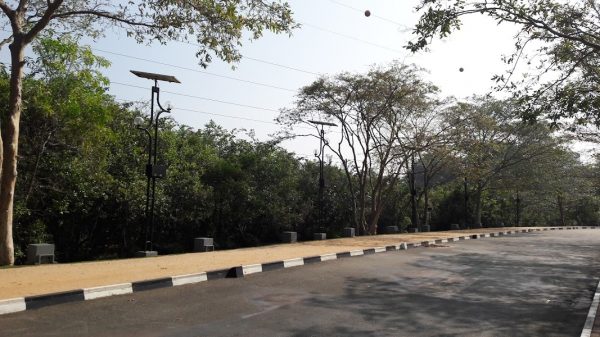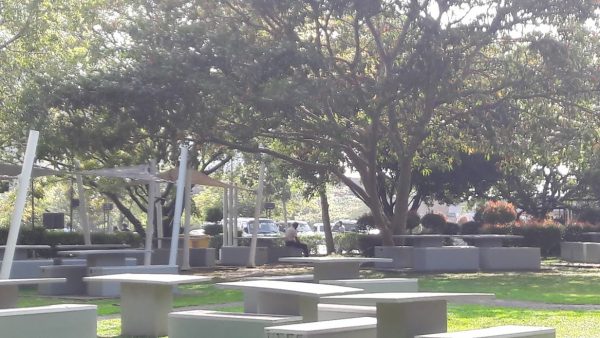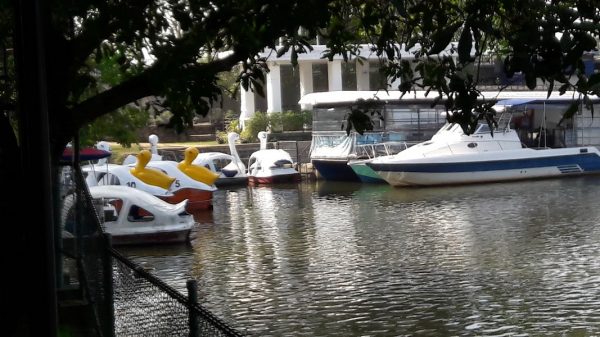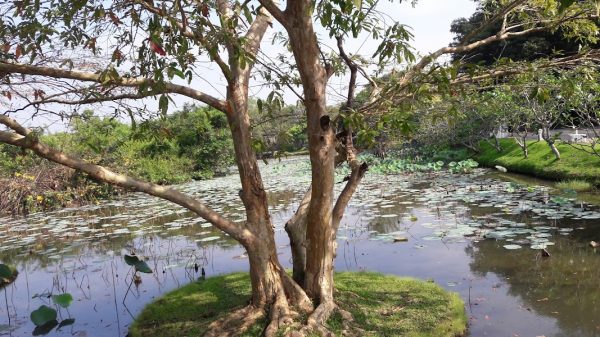Diyatha Uyana – serenity amidst tree-lined boulevards
By Arundathie Abeysinghe 
 Situated approximately nine kilometers from the busy metropolis and constructed on the banks of the *Diyawanna Oya, Diyatha Uyana located at Polduwa junction, Battaramulla features enormous swaths of green marsh land, well-maintained walking paths and boat rides on the river…
Situated approximately nine kilometers from the busy metropolis and constructed on the banks of the *Diyawanna Oya, Diyatha Uyana located at Polduwa junction, Battaramulla features enormous swaths of green marsh land, well-maintained walking paths and boat rides on the river…
A relaxing trail away from the hustle and bustle of Colombo City, yet situated in close proximity to outskirts of the busy metropolis…
Diyatha Uyana (meaning “water garden”), a novel outdoor recreational area located in the suburban area of Battaramulla has been constructed on a marshy land on the banks of the *Diyawanna Oya.
The Park is man-made, yet the architects have well-preserved the existing ponds including small ponds adding glamour and diversity to the Park while maintaining the pristine natural environment.
Diyatha Uyana is an exquisite creation of architecture that echoes Kandyan architecture and aristocratic southwestern art styles with traces of regional modernism.
Referred to as the “Gardens by the bank of Diyawanna Oya” by many visitors, the Park is popular as an unwinding destination.

Those who wish to relax basking in the glory of the surroundings while experiencing the cool breeze can sit on the stone benches along the track or go on boat rides while immersing the picturesque waters during mornings or evenings. Lush greenery and peaceful surroundings amidst the placid waters of the Diyawanna Oya provide visitors an ideal place to unwind or relax.
Diyatha Uyana spans an area of approximately 88 hectares and the marshes surrounding the Park serve as a natural water retention measure against floods.
As Diyatha Uyana was originally a wetland and Diyawanna Lake is situated in close proximity to the Park, there are several aquatic birds in the Park including ducks (Anatidae), pelicans (Pelecanus), especially geese (Anser) who roam in the Park freely and have made the Park their home.
Bequeathing visitors with spectacular vistas of the lake, the main attraction of the Park is the restaurant in the train, a popular venue during night time.

Diyawanna Oya, the artificial lake in Sri Jayewardenapura Kotte is not a new feature, instead it has been in existence for centuries during the period of the *Kingdom of Kotte. The little isle known as “Duwa” a 5 hectare (12 acre) island in Diyawanna Oya had been the residence of Nissanka Alagakkonara, Chief Minister and Counsellor of King Wikramabahu III (1357-1374). Chief Minister Alagakkonara had held the same position and had served several years during the reign of Bhuwanekabahu V (1374-1408) too.
The commercial area of Diyatha Uyana is situated at the entrance to the Park and has food stalls, daily fairs offering different items and stalls to purchase items such as clothes and plants including flower plants. The circular aquarium featuring an interesting collection of fish is a popular attraction of children as well as adults.

- Convention of Malwana (1597) – An agreement between the Portuguese Colonials and the native chiefs of Ceylon in which the chiefs swore allegiance to the king of Portugal and in return were assured that their laws and customs would be left inviolate. The Convention also provided that the Ceylonese (present Sri Lankans) should render all traditional services and taxes to their new sovereign. The main objective of the Convention which was summoned after the Portuguese Colonials had already assumed control of Ceylon was to lend a guise of legality to the seizure of Ceylon by Portuguese Colonials.
- Diyawanna Oya – A lake situated within Sri Jayawardenepura Kotte, Sri Lanka. The Lake is very popular as the Parliament Building (of Sri Lanka) is built on an artificial island at the center of the Lake.
- King Don Juan Dharmapala – According to *Mahawamsa, Don João Dharmapala Peria Bandara (1541 –1597) also known as Dom Juan Dharmapala was the last king of the Kingdom of Kotte. He was the only Catholic King in Sri Lanka’s history.
- Kingdom of Kotte – A Sinhalese kingdom that flourished in *Ceylon during the 15th century. King Parakramabahu VI (1412–67) was the last native sovereign to unify all of Ceylon under one rule and by 1450, the King had with his conquest of the Kingdom of Jaffna in the Northern Peninsula unified the entire country. By 1477, almost 10 years after the death of King Parakramabahu VI, Jaffna and the powerful Kingdom of Kandy had thrown off the suzerainty of Kingdom of Kotte. In 1505, with the arrival of the Portuguese Colonials, the king of Kotte agreed to pay tribute to Portugal becoming the first Sinhalese King to accept the suzerainty of a European King. Thereafter, the Kingdom of Kotte continued to exist nominally until 1597 and with the death of its last ruler, *King Don Juan Dharmapala, sovereignty was officially passed to the king of Portugal by a written agreement between Portuguese officials and native Sinhalese chiefs at the *Convention of Malwana.
- Kotte – Sri Jayawardenepura Kotte, commonly known as “Kotte” is the legislative and administrative capital of Sri Lanka. According to scholars, Kotte (derived from “kotuwa” in Sinhala meaning fortress) has originated from a fortress constructed by Nissanka Alagakkonara.
- Mahawamsa – “Great Chronicle” or “Great Dynasty” in Sinhala is the most significant work of Sri Lankan origin written in Pali Language. This Chronicle describes life and times of Sri Lankans from the arrival of Vijaya in 43 BC to the reign of King Mahasena from sixth century BC to fourth century AD. Culawamsa (lesser chronicle) covers the period from fourth century AD to British takeover of Sri Lanka in 1815. Mahawamsa consists of three parts covering a historical record of over two millennia. It is considered as the world’s longest unbroken historical record.








